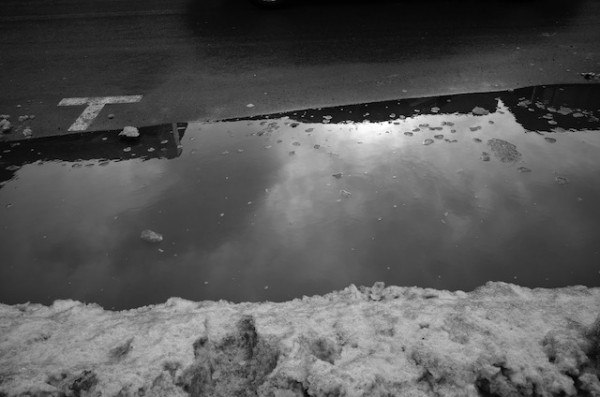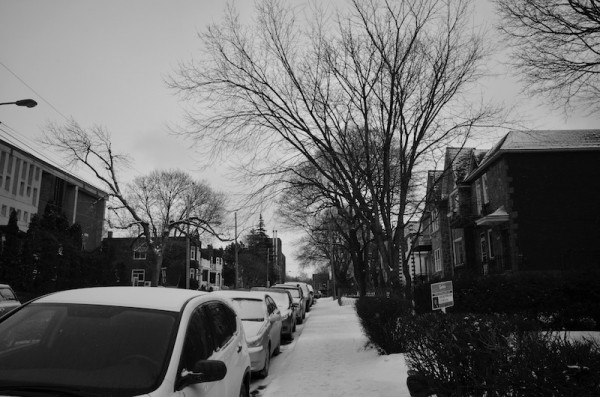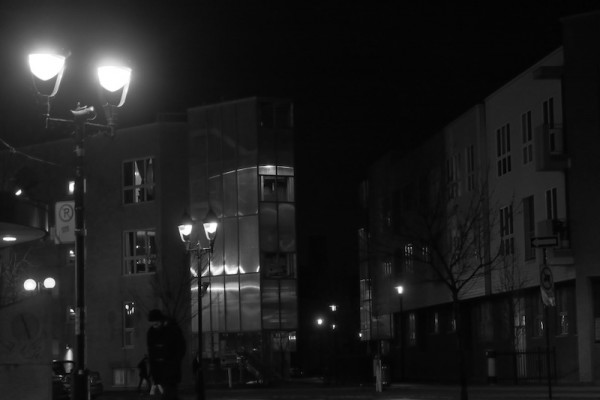Preliminary
The proximate environment we delve into daily, or in periodic fashion, in daytime and nightime, and across the seasons, is so familiar to us that we usually become spatially and visually aware of its poetics, i.e. in any articulated way, only at moments of changes and/or interesting developments : physical and social out there and behavioral in us: household composition, household exterior activity pattern change, aging, etc.
What is the proximate environment made of?
It is firstly « my fronting street » extending one bloc on each side of my place of residence, then “my direct neighbors” extending to the apt buildings on each side and across the street from mine, then “my walking distance service area” including nearest parking space, bank, school, supermarket, shops, subway and bus stations, government liquor store, post office, pharmacy and cultural venues such as places of worship, sport and recreation, etc.
Secondly, in same order of familiarity, it is the environment around the work place, near friends places, near favorite leisure places outdoor and indoor, etc. i.e. any itinerary or set of places we use and encounter in repeated if not daily manner.
Think of my “fifteen-twenty minutes walking distance” service area as an ellipse with my place of residence located on one of its two foci… averaging ten minutes walk to its limit on the short dimension and more like twenty plus minutes on the long one.
Shown on the feature image is my nearest, five minutes walk, to a bus station serving one bus line.
The next nearest walk, to a transfer station serving three bus lines and two subway lines, lies ten minutes away in the opposite direction, with its pharmacies, supermarket, state run liquor store, eateries, and the varied faces and languages of my neighbors.
The furthest walk is to an open shopping mini mall, with its own parking lot and next to a subway station and to a one line bus stop. Like most every body else I will walk there on occasion for their specialty shops or drive there to purchase items too heavy to carry back.
A proximate environment experience is therefore conditioned by all these cost benefits calculations of walking vs driving vs target venues!
What adds up to a list of venues with names refering to their functional, or social and cultural, “identity” does not provide an insight into their spatial poetic beyond the fact of their proximity to one’s place of residence. For that insight to happen we have to remember the fundamental conditions for experiencing the poetic of the proximate environment:
- one has to be walking, allowing for all the senses, and possible associations, to come in to play
- one has to be exposed daily to these experiences throughout the year’s seasons as well as during the day and at night
In the following Preview I present and briefly discuss a sample of situations that illustrate the main sets of features of the proximate environment that condition our experience of its poetics.
The ground, with its various textures and borders delimiting areas and territories, the extent and mode of their accessibility, etc. and how these features modulate our movement and our sensory experiences at the basis of the poetics of proximate environment.
What itinerary we choose, which puddle we try to avoid, how wet asphalt can turn to mirror bringing down what is up, which side is shady or sunny, are only some of the way we can poetically process the apparent banality of daily routine. (See image below)
The changes of level are probably the most evocative of the ground experiences particularly when articulated in terms of cascading platforms inviting seasonal uses, providing resting moments between climbs, etc.
The position differences that come with changes of levels, however minute, will introduce interesting rapport between people, and between people and things, at the different levels (See image below)
The vertical plane elements such as hedges, walls, screens of all sorts and their degree of definition and openness, and how they modulate the variety of transition experiences provide punctuated moments not only of social and functional awareness but also of sensorial modulation from which spatial poetics arise.
The vertical point-elements such as trees, roofs, chimneys, etc. that reach for the sky and punctuate our itineraries with their shadows, and that provide near and far landmarks, give us a sense of spatial and visual sequence, and rhythm i.e. poetic scansion … (See image below)
Discussion
The next posts will examine these phenomena, in terms of situations and of physical and spatial features discussed above, along certain walks usually taken whether it be in my neighborhood or in various parts of the city…by day and by night.
Think of “A walk around the bloc” with the late Kevin Lynch.
Think of a child’s walk to school.
Think of getting a pint of milk at the convenience store.
Think of a walk along a tree lined avenue when the first buds come out.
Think of a walk on campus with a good friend.
Etc.
Think then of remembering what it is that caught your eye and mind, along these walks you may wish to describe, in the same way as what it is in a poem that would make you remember some verses, many years after having read them.
Think for example of Roethke’s famous poem “The Waking” which includes these haunting ten syllable verses whose sonorities and rhythm allow one to memorize them as each verse is “carried” mnemonically by the different propositions and by the differential distribution of three major stressed vowels: A, I and O.
I wake to sleep and take my waking slow
I feel my fate in what I cannot fear
I learn by going where I have to go
Whether by day or by night, whether sunny or raining, etc. I will be taking these walks, and producing images that embody perhaps a set of poetic experiences that progress from sensing to feeling, to thinking … to deciding perhaps “where I have to go” next!
All photos credit Maurice Amiel
